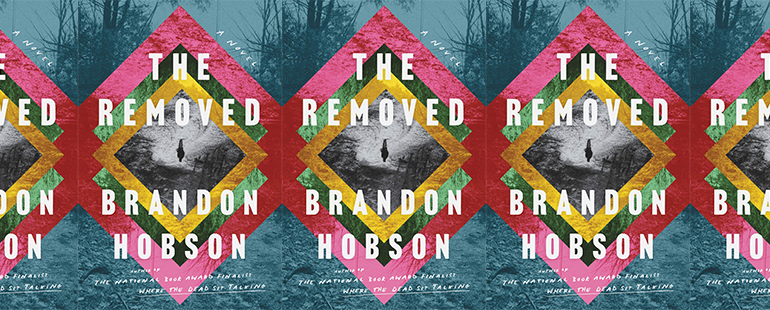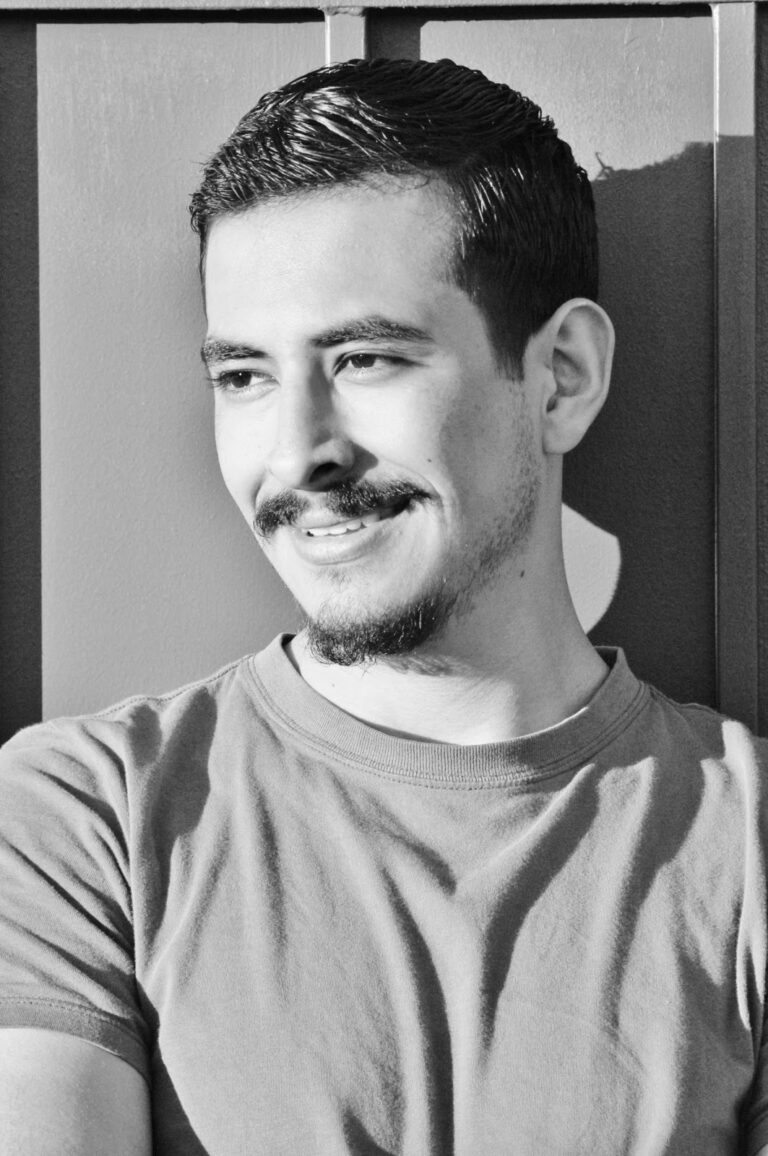“I really try to let the characters speak for themselves”: An Interview with Brandon Hobson

Brandon Hobson, a citizen of the Cherokee Nation Tribe of Oklahoma, is not a writer whose style can be easily categorized or pinned down. His first works—The Levitationist (2006) and Deep Ellum (2014)—are poetic and well-crafted, and decidedly sparing, while his National Book Away Finalist Where the Dead Sit Talking (2018) is a more insistent and direct work, tackling family struggles as well as issues of inclusion and belonging in a story pocked with music and dialogue. The Removed, out today, showcases Hobson’s growing talent in addition to his passion to continue working with new aesthetics. It weaves the spiritual, the cultural, and the familial onto the page in a clear, artful look at the way ancestry and heritage mark us, support us, guide us, and inform our past, present, and future existence.
The novel begins with the murder of Ray-Ray Echota, a Native American teenager, who was unjustly shot and killed by a police officer at a mall in Oklahoma. After months of investigation, the case is dropped, even though the shooting was racially motivated. Hobson then blink-cuts to fifteen years later, when Ray-Ray’s mother, father, and siblings are gathering for their annual bonfire in his honor, meeting to share stories of his boyhood charm as a Pee-Wee Herman impersonator, a lover of motorcycles, and a grinning symbol of youth. But the conflict around this bonfire assembly is many-fold. Ray-Ray’s father, Ernest, has Alzheimer’s; his younger brother, Edgar, is experiencing drug addiction and refuses to come home; his sister, Sonja, holds a deeply embedded need for retribution; and his mother, Maria, is valiantly trying to hold them all together. Just as this yearly bonfire seems doomed, Wyatt, a foster boy, appears, bearing a personality more than strikingly similar to Ray-Ray’s. In his short stay with Ernest and Maria, he becomes the conductor between the present-day and the Echota’s ancestors, as well as a means to perhaps bring this family together one more time.
Woven between the chapters narrated by the Echota family members, Hobson brings in the particularly potent voice of Tsala, a Nunnehi, or immortal spirit. He is a type of ancestor to the family—members of the Cherokee tribe who stood up against the then-impending Trail of Tears, willing to die in order to refute the unjust evils of the soldier’s missives. Tsala, who often brings parables and other cultural stories into the novel, gives us a direct link to the Trail of Tears, recounting some of its more personal atrocities: “I heard the laughter of soldiers. Laughter! They were careless toward our people. How badly they treated them. I watched it day after day. I heard their laughter over the cries of pain and wondered how their souls could be so corrupt and without empathy. Where was their sense of humanity?” Tsala’s sections of The Removed are unlike anything Hobson has written before, dealing aggressively and straightforwardly with Cherokee tribal culture and history.
The family, too, highlights Hobson’s engagement with this history and cultural bigotry as they deal with present-day discrimination and ignorance. Edgar is forced to address cultural misappropriations and bust the stereotypes of a former friend: “Is it true the Natives had elongated skulls?” he’s asked. “What do you know about that? Can you enlighten me, Jim Thorpe?” Sonja is similarly quizzed about her ethnicity by a new date:
‘I was thinking you were Hispanic. I mean, I knew you were part something, something, but I wasn’t sure.’
‘I’m something,’ I said.
He laughed, oddly, and I sensed a part of him I didn’t care for. Why he’d said it that way: something.
Through Wyatt’s interactions with Ernest, on the other hand, Hobson lifts tribal spiritualism into a place where it is appreciated rather than diminished. Ernest believes that Wyatt has been sent to the family, a reincarnation of sorts—an embodiment of his lost son, Ray-Ray—intended to bring them closure. To Maria, Ernest confides what he suspects, that “the Great Spirit may have sent Ray-Ray back to us in another form” and that perhaps this connection will help the rest of the family begin healing.
Hobson takes Edgar, too, deep into the realm of ancestry. He overdoses and ends up in The Darkening Lands, a purgatorial landscape of gray and storms, populated with suicide victims and mirroring Andrew Jackson’s persecution of Native Americans in the guise of a nightmarish virtual reality game called Savages. The Darkening Land brings Edgar so close, in fact, to his ancestors that he begins to see them in a ghostly version of their flight so long ago: “I saw many people that night: apparitions of women and men with blankets over their shoulders, walking down the hallway. I saw children being carried. I saw people crawling and reaching out to me for help. They kept coming and coming, walking down the hallway past my bedroom. In the dark I couldn’t see their faces, but their bodies were struggling against a wind, pushing forward. My ancestors, I thought. My ancestors walking the Trail.”
One more side to Hobson’s exploration of cultural heritage is present in Maria, who stoically and heroically attempts to hold the remnants of her family together, showing the strength, determination, and fortitude of the entire tribe of Cherokee ancestors who fought until the bitter end. When she looks in the mirror, she sees “a face marked by lines and age. A face marked by the persistence of hope, tragedy, abandonment, and grief,” which reminds her that she is “a woman who maintained strength through everything.” Maria’s resilience and determination are exactly what the entire family seeks, each in his or her own way. For Ernest, it is embodied in his battle to remember the past, especially what was handed down to him through generations, while for Sonja it is about either making good on her vengeance over Ray-Ray’s death or finally letting go. Edgar, too, even in The Darkening Land, is confronted with an opportunity to embrace his present alongside his past: “The sky was pink and yellow, and cherry blossoms spilled onto the trail ahead. Feathers were soon falling all around me, flooding the trail, as white as a fresh winter snow. The winding trail was beautiful. I saw my ancestors ahead, but they were not crawling and wailing, they were standing. Their bodies filled the distance. I walked to them and did not grow tired. The trail before me was blazing with light.”
The Removed is a brilliant, artfully crafted novel of Native heritage, family dynamics, and ancestral hope. I recently spoke with Hobson about these and other elements of the novel, in addition to the writing and revision process.
J.A. Tyler:The Removed shares some interesting associations with your previous novel Where the Dead Sit Talking, including drug addiction, suicide, foster children, imprisoned parents, and rehab. What draws you to this type of content?
Brandon Hobson: I was a social worker for seven years and saw a lot of these issues in my work. As Nikki Giovanni says, one of the things that should draw us to stories is empathy, and it seems to me we all need more empathy, especially people who are struggling in the system.
JAT: Music is a large part of your works as well, often functioning as anchor points for characters. Do you listen to music while you write? Do you play the songs that infiltrate the narrative, as you craft it?
BH: I can’t listen to music or anything really when I’m writing, though if I’m working in a coffee shop somewhere and music is playing, I can usually work through the distraction. I do love listening to music and can become somewhat obsessed with bands or musicians from time to time. In this book, Elliot Smith and Hendrix and Cobain are all mentioned as being seen in The Darkening Land, this mythical place where Edgar finds himself. Sometimes listening to music inspires images or scene ideas.
JAT: Along with music, what other outside elements inspire or enliven your writing process?
BH: Probably reading more than anything else. I take walks, which can be inspiring, but there’s nothing like reading good fiction.
JAT: Many of the characters in The Removed have been stripped of control over their lives, whether by way of Alzheimer’s, drug addiction, or emotional anxiety. How do you keep the writing moving forward in a controlled way when the characters are mired in obstacles and embattled with chaos?
BH: Oh, man, that’s a hard question. Part of it comes back to what Charles Johnson talks about in The Way of the Writer, having a sense of pleasure while working. I really try to let the characters speak for themselves and try to maintain a continued sense of propulsion and urgency. This isn’t easy, you know this. We have to rely on lots of revision, multiple drafts even, to get it right.
JAT: Would you characterize your typical writing process as more first draft heavy, or more revision heavy?
BH: I’d say it’s always first draft heavy—this is the most enjoyable for me. It takes multiple revisions, cutting, rearranging to get it just right. Working with an editor or a good reader is crucial for the revision process.
JAT: “Echota” in Cherokee means “blessing” but it also connects with the Treaty of New Echota, which helped bring about the forced removal of the Cherokee from their land. What is it like to write fiction that intersects with such a defining and deafening history?
BH: Good eye, J.A. I tried as well as I could to maintain a balance of the historical with the mythical. Part of what was fun was writing the historical from the perspective of a spirit who crawls out of the grave and narrates what happened along with periodically retelling traditional Cherokee stories to his son. There’s a lot to work with there, of course, so I had to pick and choose what I thought worked best with the family’s narratives.
JAT: In addition to the parables Tsala embeds throughout the book, there’s also an abundance of birds—owls, hawks, a red fowl—that have spiritual meaning. How important were these cultural and literary symbols during your planning and writing process?
BH: These are all very important because they’re part of the earth and nature. Owls can be very scary or important and can be representative of being messengers. I chose the word “fowl” here as a metaphor for Edgar’s addiction because “fowl” sounds so much more cryptic and surreal than “bird” or “Sparrow” or even “chicken.”
JAT: In many ways, the Echotas are asked to represent the entire Cherokee culture for other characters. Does that mirror how it feels for you as a citizen of the Cherokee Nation Tribe of Oklahoma, that your writing may be somehow expected to represent an entire group of people?
BH: They’re not supposed to represent an entire culture so much as I hope they just show a family who’s struggling with loss and trying to heal after such a tragedy. When I started this book, I was thinking a lot about the police violence against Natives and Native teens in general, and I wanted to show the effects of this violence on a family. In this way, I hope people can see them as any other family.
JAT: As the world around you changed during the drafting process, so many upheavals and tragic moments across the country, how did that transform or change the novel?
BH: I think it made me think of darker moments in the book for sure, to focus on the struggle and threats against the characters.
JAT: How have you grown or matured as a writer between your first three books (The Levitationist, Deep Ellum, and Desolation of Avenues Untold) and the latest two novels?
BH: Part of what I’m interested in as a writer is not falling into one specific aesthetic or style of book or writing. I hope that I can continue to do different things in terms of form or structure.


